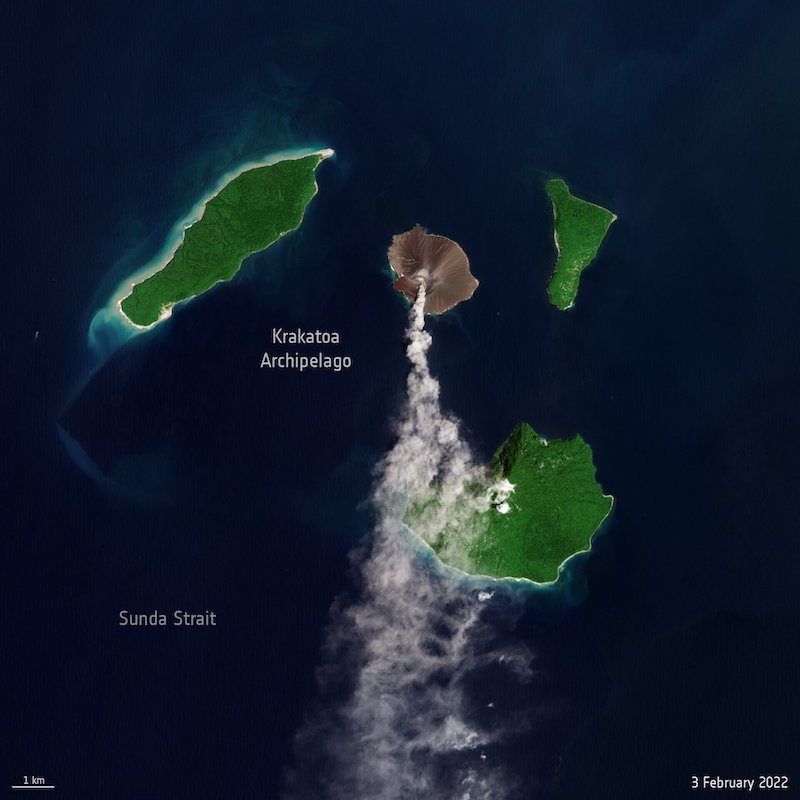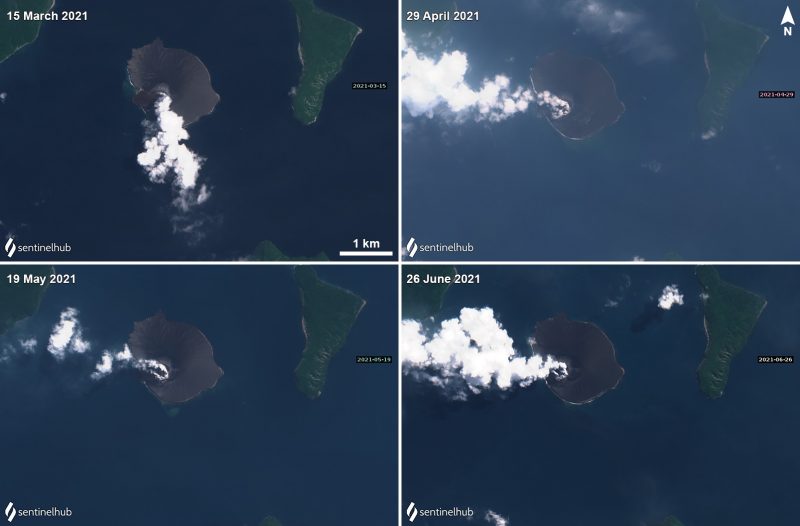
New eruption at Anak Krakatoa
Indonesia’s Krakatoa Volcano erupted famously in 1883, destroying over 70% of the island of Krakatoa and disrupting its surrounding small islands. In 1927, a new volcanic island known as Anak Krakatau (Child of Krakatoa), emerged from the caldera left behind in 1883. Anak Krakatau has been one of Earth’s most active volcanos since the late 20th century. A large collapse caused a deadly tsunami in 2018. This week, on February 3, 2022, Anak Krakatoa began erupting again. The European Space Agency (ESA) shared the image above from its Sentinel-2 satellite, showing the new eruption sent a thick column of gas, and possibly ash, rising to about 660 feet (200 m) above the volcano’s upper rim.
Volcanic ash can gum up an airplane’s engines and even bring an airplane down. This week’s eruption prompted the Anak Krakatau Volcano Observatory to raise the aviation color code to orange. That tells the aviation community about the potential presence of volcanic ash in the atmosphere. A code orange means that the volcano is showing “heightened unrest with an increased likelihood of eruption,” and/or it means a volcanic eruption is already “underway with no or minor ash emission.”
One of Earth’s most active volcanoes
Anak Krakatoa has been erupting off and on since the late 20th century. The deadly 2018 tsunami was caused by an underwater collapse. Eruptions in 2019 and 2020 followed. The images below show Setntinel-2’s monitoring of this volcano from space throughout 2021.


Bottom line: Indonesia’s Anak Krakatoa Volcano began a new eruption on February 3, 2022.
The post Anak Krakatoa began a new eruption February 3 first appeared on EarthSky.
from EarthSky https://ift.tt/sa8m93R

New eruption at Anak Krakatoa
Indonesia’s Krakatoa Volcano erupted famously in 1883, destroying over 70% of the island of Krakatoa and disrupting its surrounding small islands. In 1927, a new volcanic island known as Anak Krakatau (Child of Krakatoa), emerged from the caldera left behind in 1883. Anak Krakatau has been one of Earth’s most active volcanos since the late 20th century. A large collapse caused a deadly tsunami in 2018. This week, on February 3, 2022, Anak Krakatoa began erupting again. The European Space Agency (ESA) shared the image above from its Sentinel-2 satellite, showing the new eruption sent a thick column of gas, and possibly ash, rising to about 660 feet (200 m) above the volcano’s upper rim.
Volcanic ash can gum up an airplane’s engines and even bring an airplane down. This week’s eruption prompted the Anak Krakatau Volcano Observatory to raise the aviation color code to orange. That tells the aviation community about the potential presence of volcanic ash in the atmosphere. A code orange means that the volcano is showing “heightened unrest with an increased likelihood of eruption,” and/or it means a volcanic eruption is already “underway with no or minor ash emission.”
One of Earth’s most active volcanoes
Anak Krakatoa has been erupting off and on since the late 20th century. The deadly 2018 tsunami was caused by an underwater collapse. Eruptions in 2019 and 2020 followed. The images below show Setntinel-2’s monitoring of this volcano from space throughout 2021.


Bottom line: Indonesia’s Anak Krakatoa Volcano began a new eruption on February 3, 2022.
The post Anak Krakatoa began a new eruption February 3 first appeared on EarthSky.
from EarthSky https://ift.tt/sa8m93R

Aucun commentaire:
Enregistrer un commentaire